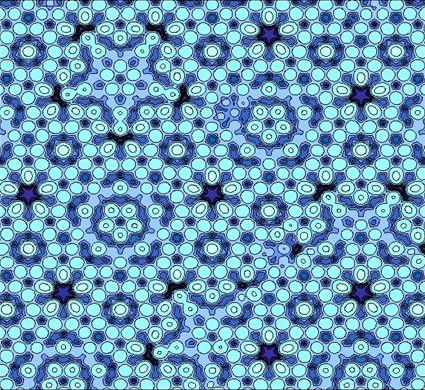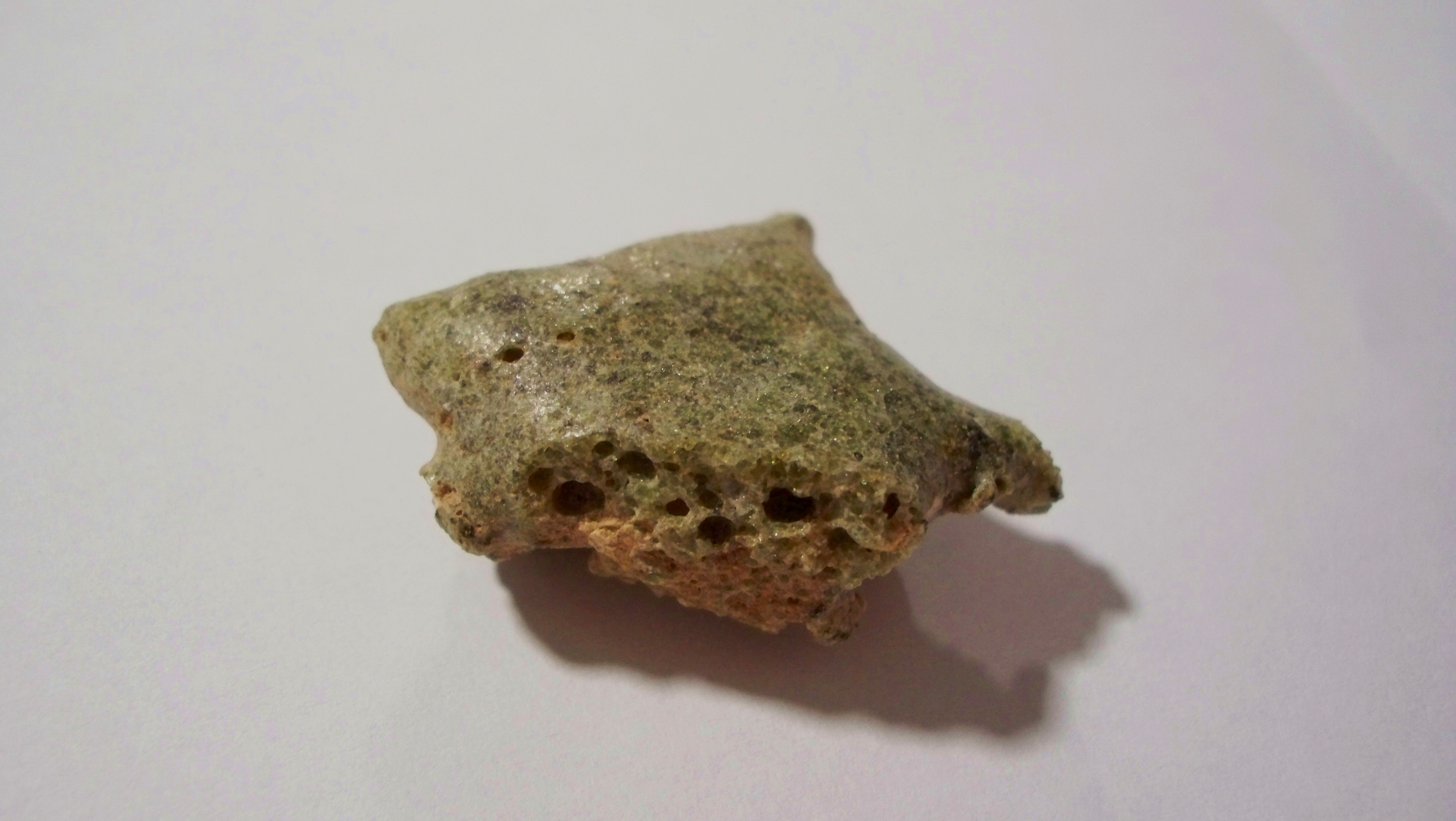|
Quasicrystalline
A quasiperiodic crystal, or quasicrystal, is a structure that is ordered but not periodic. A quasicrystalline pattern can continuously fill all available space, but it lacks translational symmetry. While crystals, according to the classical crystallographic restriction theorem, can possess only two-, three-, four-, and six-fold rotational symmetries, the Bragg diffraction pattern of quasicrystals shows sharp peaks with other symmetry orders—for instance, five-fold. Aperiodic tilings were discovered by mathematicians in the early 1960s, and, some twenty years later, they were found to apply to the study of natural quasicrystals. The discovery of these aperiodic forms in nature has produced a paradigm shift in the field of crystallography. In crystallography the quasicrystals were predicted in 1981 by a five-fold symmetry study of Alan Lindsay Mackay,—that also brought in 1982, with the crystallographic Fourier transform of a Penrose tiling,Alan L. Mackay, "Crystallogr ... [...More Info...] [...Related Items...] OR: [Wikipedia] [Google] [Baidu] |
Paul Steinhardt
Paul Joseph Steinhardt (born December 25, 1952) is an American theoretical physicist whose principal research is in cosmology and condensed matter physics. He is currently the Albert Einstein Professor in Science at Princeton University, where he is on the faculty of both the Departments of Physics and of Astrophysical Sciences. Steinhardt is best known for his development of new theories of the origin, evolution and future of the universe. He is also well known for his exploration of a new form of matter, known as quasicrystals, which were thought to exist only as man-made materials until he co-discovered the first known natural quasicrystal in a museum sample. He subsequently led a separate team that followed up that discovery with several more examples of natural quasicrystals recovered from the wilds of the Kamchatka Peninsula in far eastern Russia. Several years later, he and collaborators reported the accidental synthesis of a previously unknown type of quasicrystal in the r ... [...More Info...] [...Related Items...] OR: [Wikipedia] [Google] [Baidu] |
Aperiodic Tiling
An aperiodic tiling is a non-periodic tiling with the additional property that it does not contain arbitrarily large periodic regions or patches. A set of tile-types (or prototiles) is aperiodic if copies of these tiles can form only non- periodic tilings. The Penrose tilings are the best-known examples of aperiodic tilings. Aperiodic tilings serve as mathematical models for quasicrystals, physical solids that were discovered in 1982 by Dan Shechtman who subsequently won the Nobel prize in 2011. However, the specific local structure of these materials is still poorly understood. Several methods for constructing aperiodic tilings are known. Definition and illustration Consider a periodic tiling by unit squares (it looks like infinite graph paper). Now cut one square into two rectangles. The tiling obtained in this way is non-periodic: there is no non-zero shift that leaves this tiling fixed. But clearly this example is much less interesting than the Penrose tiling. In order t ... [...More Info...] [...Related Items...] OR: [Wikipedia] [Google] [Baidu] |
Dan Shechtman
Dan Shechtman ( he, דן שכטמן; born January 24, 1941)Dan Shechtman . (PDF). Retrieved on January 28, 2012. is the Philip Tobias Professor of Materials Science at the Technion – Israel Institute of Technology, an Associate of the United States Department of Energy, US Department of Energy's Ames National Laboratory, and Professor of Materials Science at Iowa State University. On April 8, 1982, while on sabbatical at the National Institute of Standards and Technology, U.S. National Bureau of Standards in Washington, D.C., Shechtman discovered the icosahedral phase, which opened the new field of quasicrystal, quasiperiodic crystals. He was awarded the 2011 Nobel Prize in Chemistry for the discovery of quasicrystals, making him one of six Israelis who have won the Nobel Prize in Chemis ... [...More Info...] [...Related Items...] OR: [Wikipedia] [Google] [Baidu] |
Icosahedrite
Icosahedrite is the first known naturally occurring quasicrystal phase. It has the composition Al63Cu24Fe13 and is a mineral approved by the International Mineralogical Association in 2010. Its discovery followed a 10-year-long systematic search by an international team of scientists led by Luca Bindi and Paul J. Steinhardt to find the first natural quasicrystal. It occurs as tiny grains in a small sample labelled "khatyrkite" (catalog number 46407/G, housed in The Museum of Natural History, University of Florence, Italy), collected from an outcrop of weathered serpentinite in the Khatyrka ultramafic zone of the Koryak-Kamchatka area, Koryak Mountains, Russia. The rock sample also contains spinel, diopside, forsterite, nepheline, sodalite, corundum, stishovite, khatyrkite, cupalite and an unnamed AlCuFe alloy. Evidence shows that the sample is actually extraterrestrial in origin, delivered to the Earth by a CV3 carbonaceous chondrite asteroid that dates back 4.5 Gya. A geological ... [...More Info...] [...Related Items...] OR: [Wikipedia] [Google] [Baidu] |
Hao Wang (academic)
Hao Wang (; 20 May 1921 – 13 May 1995) was a Chinese-American logician, philosopher, mathematician, and commentator on Kurt Gödel. Biography Born in Jinan, Shandong, in the Republic of China (today in the People's Republic of China), Wang received his early education in China. He obtained a BSc degree in mathematics from the National Southwestern Associated University in 1943 and an M.A. in Philosophy from Tsinghua University in 1945, where his teachers included Feng Youlan and Jin Yuelin, after which he moved to the United States for further graduate studies. He studied logic under W.V. Quine at Harvard University, culminating in a Ph.D. in 1948. He was appointed to an assistant professorship at Harvard the same year. During the early 1950s, Wang studied with Paul Bernays in Zürich. In 1956, he was appointed Reader in the Philosophy of Mathematics at the University of Oxford. In 1959, Wang wrote on an IBM 704 computer a program that in only 9 minutes mechanically pr ... [...More Info...] [...Related Items...] OR: [Wikipedia] [Google] [Baidu] |
Penrose Tiling (Rhombi)
Penrose may refer to: Places United States * Penrose, Arlington, Virginia, a neighborhood * Penrose, Colorado, a town * Penrose, Philadelphia, a neighborhood * Penrose, North Carolina, an unincorporated community * Penrose, Utah, an unincorporated community Commonwealth of Nations * Penrose, Cornwall, a country house (in private ownership) and National Trust estate in west Cornwall, including Loe Pool and Bar * Penrose, New Zealand, a suburb of Auckland * Penrose, New South Wales (Wingecarribee), a small town south-west of Sydney, Australia * Penrose, New South Wales (Wollongong), a suburb of Wollongong, New South Wales, Australia Other uses * Penrose Stout, American architect * Penrose (surname), including a list of people with the name * Penrose (brand), a brand name List of Conagra brands, owned by ConAgra Foods, Inc., used only for pickled sausages * Penrose Medal, the top prize awarded by the Geological Society of America to those who advance the study of geoscience * ''The Pe ... [...More Info...] [...Related Items...] OR: [Wikipedia] [Google] [Baidu] |
Trinitite
Trinitite, also known as atomsite or Alamogordo glass, is the glassy residue left on the desert floor after the plutonium-based Trinity nuclear bomb test on July 16, 1945, near Alamogordo, New Mexico. The glass is primarily composed of arkosic sand composed of quartz grains and feldspar (both microcline and smaller amount of plagioclase with small amount of calcite, hornblende and augite in a matrix of sandy clay) that was melted by the atomic blast. It was first academically described in ''American Mineralogist'' in 1948. It is usually a light green, although red trinitite was also found in one section of the blast site,G. Nelson Eby1, Norman Charnley, Duncan Pirrie, Robert Hermes, John Smoliga, and Gavyn RollinsTrinitite redux: Mineralogy and petrology''American Mineralogist'', Volume 100, pages 427–441, 2015 and rare pieces of black trinitite also formed. It is mildly radioactive but safe to handle. Pieces of the material may still be found at the Trinity site as of 2018, al ... [...More Info...] [...Related Items...] OR: [Wikipedia] [Google] [Baidu] |
Trinity (nuclear Test)
Trinity was the code name of the first detonation of a nuclear weapon. It was conducted by the United States Army at 5:29 a.m. on July 16, 1945, as part of the Manhattan Project. The test was conducted in the Jornada del Muerto desert about southeast of Socorro, New Mexico, on what was then the USAAF Alamogordo Bombing and Gunnery Range, now part of White Sands Missile Range. The only structures originally in the vicinity were the McDonald Ranch House and its ancillary buildings, which scientists used as a laboratory for testing bomb components. A base camp was constructed, and there were 425 people present on the weekend of the test. The code name "Trinity" was assigned by J. Robert Oppenheimer, the director of the Los Alamos Laboratory, inspired by the poetry of John Donne. The test was of an implosion-type nuclear weapon, implosion-design plutonium device, informally nicknamed "The Gadget", of the same design as the Fat Man bomb later atomic bombings of Hiroshima and N ... [...More Info...] [...Related Items...] OR: [Wikipedia] [Google] [Baidu] |
Luca Bindi
Luca Bindi (born 1971) is an Italian geologist. He holds the Chair of Mineralogy and Crystallography and is the Head of the Department of Earth Sciences of the University of Florence. He is also a research associate at the Istituto di Geoscienze e Georisorse of the National Research Council (Italy) (CNR). He has received national and international scientific awards that include the President of the Republic Prize 2015 in the category of Physical, Mathematical and Natural Sciences. Since 2019 is a Member of the National Academy of Lincei. Bindi is credited with the co-discovery of the first known natural quasicrystal, having identified a potential candidate from the mineral collection at the "Università di Firenze". The discovery ultimately showed that quasicrystals can form spontaneously in nature and remain stable for geological times. Recognition Awards for his research, include: * Panichi Prize for mineralogical investigations of the Italian Society of Mineralogy and Petro ... [...More Info...] [...Related Items...] OR: [Wikipedia] [Google] [Baidu] |
Nobel Prize In Chemistry
) , image = Nobel Prize.png , alt = A golden medallion with an embossed image of a bearded man facing left in profile. To the left of the man is the text "ALFR•" then "NOBEL", and on the right, the text (smaller) "NAT•" then "MDCCCXXXIII" above, followed by (smaller) "OB•" then "MDCCCXCVI" below. , awarded_for = Outstanding contributions in chemistry , presenter = Royal Swedish Academy of Sciences , location = Stockholm, Sweden , reward = 9 million SEK (2017) , year = 1901 , holder = Carolyn R. Bertozzi, Morten P. Meldal and Karl Barry Sharpless (2022) , most_awards = Frederick Sanger and Karl Barry Sharpless (2) , website nobelprize.org, previous = 2021 , year2=2022, main=2022, next=2023 The Nobel Prize in Chemistry is awarded annually by the Royal Swedish Academy of Sciences to scientists in the various fields of chemistry. It is one of the five Nobel Prizes established by the will of Alfred Nobel in 1895, awarded for ... [...More Info...] [...Related Items...] OR: [Wikipedia] [Google] [Baidu] |
Manganese
Manganese is a chemical element with the symbol Mn and atomic number 25. It is a hard, brittle, silvery metal, often found in minerals in combination with iron. Manganese is a transition metal with a multifaceted array of industrial alloy uses, particularly in stainless steels. It improves strength, workability, and resistance to wear. Manganese oxide is used as an oxidising agent; as a rubber additive; and in glass making, fertilisers, and ceramics. Manganese sulfate can be used as a fungicide. Manganese is also an essential human dietary element, important in macronutrient metabolism, bone formation, and free radical defense systems. It is a critical component in dozens of proteins and enzymes. It is found mostly in the bones, but also the liver, kidneys, and brain. In the human brain, the manganese is bound to manganese metalloproteins, most notably glutamine synthetase in astrocytes. Manganese was first isolated in 1774. It is familiar in the laboratory in the form of the ... [...More Info...] [...Related Items...] OR: [Wikipedia] [Google] [Baidu] |





